

Your mag
Recognized in Spring 2012, YOURMAG ’s goal is to promote knowledge of the magazine industry by giving students the opportunity to be responsible for all aspects of a monthly lifestyle publication. With an audience of urban college students in mind, members create content across a broad range of topics and mediums, including style, romance, music, pop culture, personal identity, and experiences. YourMag’s overarching aim is to foster a positive, inclusive community of writers, editors, and artists.

volume 24 | issue 1 | OCTOBER 2025
LAUREN MALLETT
Managing Editor
Molly dehaven
Head Designer
Emilie Dumas
Photo Director
emma fisher Asst. Photo Director
sienna Leone Art Director
izzie maher Asst. Art Director
ALexandra Azan YMTV Director
Lucy Latorre Web Editor
Izzie Claudio Editor-in-Chief
Mckenna smith Editorial Director
RYAN WILLIAMS
Asst. Editorial Director
Emily Hamnett Head Stylist
isaiah flynn Asst. Head Stylist
Payton Montaina Copy Chief
Anna chalupa Head Proofreader
Emma Bowen Creative Director
JAVIER GOMEZ Asst. Creative Director
Molly peay Romance Editor
Heather Thorn Asst. Romance Editor
KAT BOSKOVIC Style Editor
Isabella Castelo Living Editor
Olivia flanz A&E Editor
ELLA DONOGHUE Asst. Web Editor
Copy editors: Kristin Barrett, Jules Telfort, Bella Nordman
GRAPHIC designERS: Sydney Beliveau, Izzie Claudio, Elizabeth Liatsos, Lauren Mallett, McKenna Smith, Abigail Tangonan, Tehya Tenasco
Proofreaders: Kat Boskovic, Grace Chandler, Tiana DiStasio, Bella Nordman, Jules Telfort


LetterfromtheEditor
Dear readers,
The beauty of primary colors is that they are the building blocks for every color we know and love. A new school year brings a return to those very same foundations, the primary colors that make up who we are. A new school year is an important reflection on how our past, present, and future converge. In this bright issue, we ask the never-ending questions of relationships, those that have been and those to come. Is there truly a recipe for a dream guy? Why do we tend to find love when we least expect it? Is it better to be ghosted? We appreciate the television shows of our childhood and how they formed us, and how the television of today continues to impact our outlook. We take a look at the phenomenon of the performative man and the “back to basics” approach to style. We daydream about what could have been, observe the silent beauty of the present, and dive into the fundamental changes we want to see in our future.
Primary isn’t just elementary, my dear Watson. It’s the foundation that opens doors to the complexities of life. The lessons of our younger selves and the promise of our future selves make up who we are today.
Hold on tight to all the crayons in your box, readers, and look forward to the art you will create. Enjoy our October 2025 issue: Primary.
With love, Izzie Claudio

Building A Better Boy






WRITTEN BY ELIJAH ST. KING
As an integral part of my childhood, I found myself living vicariously through the trials and tribulations of Nikki Maxwell. For a closeted teenager, there was nothing like seeing the girl version of you live all the lives you wanted: ice skater, fairy tale princess, pop star—the list goes on. I often found myself surfing the Dork Diaries website, seeing the submissions sent in by kids like me, wondering which ones were also in the closet, written by girls talking about the boys they liked.
In fact, I spent most of my time on the “Dream Guy Maker” game. It was simple: you and Nikki would create the perfect recipe for the boy of your dreams by answering different questions. One of the ingredients would be mixed into the bowl before the quiz revealed which Dork Diaries guy fit the man you described. I spent a solid three days trying to find which ones would give me Brandon— an early sign of my future curse: an attraction to white men.
Now, I stare at the front of the game’s home screen; a kitschy mess of cursive juxtaposed against big blocky letters on a red-heart background. Nine ingredients are laid underneath the game’s title:
1. “Sporty” on a cheap knockoff Gatorade bottle.
2. “Smarts” on a blue pepper container.
3. “Artsy” against a rainbow salt shaker.
4. Kindness on a vat of moisturizer with the tiniest spoon in the world.
5. “Humor” over a yellow triangle vial.
6. “CCP” (Cute, Cool, & Popular) on an indigo salt shaker— the uglier twin to Artsy.
7. “Shyness” displayed on a blue honey pot.
8. “Confidence” on top of an empty green box.
9. “Cuteness” in a pink candy container with a heart-shaped lid.
I look at these ingredients and I wonder: How many of these do we still use as the basis for the men we aspire to have in our lives? Beyond the immediate physical attraction, or lack thereof, what can be hallmarked about each of these basic ingredients for the “Dream Guy”?
Some girls might want Sporty, but that doesn’t mean that they want a meathead. So, how much Sporty do we pour into the mixture until he gets a concussion and we have to pour Smarts? Speaking of Smarts, is emotional intelligence in a guy included, or does that come in an unlisted bottle? Does Artsy automatically make him gay, or does the rainbow insinuate some sort of unintended queerness with his artistic side? Lord knows we could ask an Emerson man or two about that.
Kindness is the one thing everyone can agree on...hopefully. But not too kind, unless he gets too friendly with someone who wants him too. After all, if he’s your dream guy, then he’s likely someone else’s. Oh, and funny. Most people want their guys to be funny. But,
PHOTOGRAPHED BY EMMA FISHER
it makes you wonder—is he best friend funny, or a straight man making feminist literature jokes (un)funny? What if what you find funny isn’t funny to him at all? Or, worse, what if he finds everything funny?
CCP is the one I sat looking at the longest—because it’s a combination of three traits in one—insinuating that someone cute must also be cool. Therefore, if they’re cute and cool, then they must be popular. However, what makes popularity such an essential trait that it must be included in the basics of our desired man? Does the packaging include a description on the side that explains what cute entails? If attraction is subjective, does this ingredient imply a specific level of choppery if left unincluded? Is it required for us to have a man we are attracted to? Or will it make a man we’re attracted to in all ways but the physical if our definition of cute doesn’t align with the world’s?
Does him being popular make us more popular by association? Or will it make him a man who’s so swallowed up in his popularity that he can’t focus on the connections that matter? What about shyness and confidence—two equally juxtaposed ingredients? Does shyness imply some social anxiety, some level of emotional sensibility, or does it simply make him unable to communicate when trials come up? Does confidence make him boastful? Does too much make him arrogant? Does it make him assured in his ability to find someone better if the relationship breaks apart?
Lastly, if cute is already included in the CCP ingredient, what does Cuteness as an ingredient do? Does it imply a personality change, or give characteristics aligned with whatever the cook or ingredient maker’s definition of “cute” is? Who’s to say that we even want a cute dream guy? What if I want someone who’s kind of chopped? What if I want that guy who might be an Emerson 10 and a Los Angeles 2? What if I don’t want someone sporty, but someone who can carry a tune? What if I want a guy who’s sensitive but not shy? What if I want a guy who’s smarter in the sheets than he is in Google Sheets?
In the words of Anne Hathaway in The Devil Wears Prada: “What if I don’t want what you want?”
What if, instead of following these specific ingredients to conjure up the man in our mind, we put down our need to control precisely what man we want someone to be, and we open ourselves to the man that we need? I don’t want to follow a recipe with only nine ingredients; the world is too varied for nine ingredients. The world, and all of the men in it, are a series of spices themselves. Some are too spicy for our tastes. Some are too bland.
But all in all, if we keep on tasting, we’ll find the one that’s just for us. Our Dream Guy. Not on the side of a bottle, but in the recipe that’s best for us. YM
I’d RatherBe Ghosted

WRITTEN BY EMMA BOWEN
It took fourteen months to get over my ex-boyfriend. I thought I was over it four months after. Then, eight months after. I guess I missed the memo that people who are genuinely “over it” don’t spend all night crying on their couch because of how over it they are.

Allegedly healed, I ambitiously took on the dating app scene again. There was a thrill in seeing how I was wanted, desired, intriguing, enticing. I charmed, I flirted, I swiped and swiped and swiped. I fantasized and daydreamed, envisioning a future in each surface level conversation about songs on my profile or about how beautiful I was. I learned a large population of Boston would pay me to look their way. I learned I criminally overshare, potentially to a fault. And I learned who I was and who I was becoming, through the lens of those interested in learning too.
After a valiant dating app run, I was convinced I had endured it all. I dated a man for a month just for him to tell me to my face he would never date me; I talked to another guy for two months just for him to get back with his ex-girlfriend; I collected a graveyard of Spotify followers that never made it past the talking stage. Unsurprisingly, in all of them, I suffered the same fate—radio silence.
At what point does, “Oh he’s just busy,” turn into, “Well, he ghosted me?” The cat and mouse chase got old; as I memorized the formula like the back of my hand. Give them some space, distance makes the heart grow fonder, push and pull and more push and more pull. I spread myself thin feigning nonchalance as a famously very chalant person. Forced by the hand of TinderGod, I simply had to
ART BY IZZY MAHER
accept it: I was getting ghosted. I was waiting for Godot.
I vowed to never download a dating app again. Or, talk to a man ever again.
Then, I talked to a man again. Oops! Sue me. A genuine meetcute, a genuine soul, a genuine interest in me, how could you blame me? I was skeptical, sure. Through months and months of rejection I became acquainted with the custom of letting go: What’s meant to be will find you, and all those cheesy clichés. So, I convinced myself I had succeeded in letting go and this was Aphrodite rewarding me for my troubles. This one was to be mine, and I to be his.
Anyways, I found out he was engaged and set to be married in January of 2026. And, well, he ghosted me.
I was faced with mourning a relationship that was never truly mine to begin with. I had spent all that time fiending for male attention, attempting to be good enough, charismatic enough, someone of enough substance to make it to the next stage. In this situation, there was no competition. It was never a matter of being good enough, it was a race in which I did not come first. I realized this chronic fate of getting-ghosted-itis was never about me, but an ailment that plagued every man I mistakenly afforded my time and affection. My diagnosis: an incurable case of up-and-run-away-osis.
And that really blows!
So, after all my failed crushes and stages of limerence and infatuation, I’ve adopted a new mindset:

1. If your intuition is telling you he’s talking to other girls, he’s talking to other girls. Maybe even his fiancé.
2. Your internet stalking skills are not crazy— don’t let anyone convince you otherwise.
3. I’d
rather be ghosted.
I’d rather be ghosted than be told I’m undatable and have to grapple with all the reasons out of my control that created that mess. I’d rather be ghosted than knowingly resign to “second-best,” constantly compared to who came first and living in fear of never meeting that standard. I’d rather be ghosted because sometimes, it’s easier to cope with the absence of acknowledgment than the insecurity and brutality of rejection.
The beauty of The Ghost is that it’s translucent: you can see right through it all. To be Ghosted is to be abandoned, and that is the clearest and most transparent closure of all. A Ghost will only haunt you if you choose to believe that it’s there. And sometimes it will view your Instagram story—that’s just the way things go. YM




Finding My Prescription For Rose-Colored Glasses
WRITTEN BY TEHYA TENASC0
I’ve heard countless stories of love in movies, on television, and in books of fiction and poetry. In all of these instances, love is almost always depicted as ultra-romantic and ineffable. Two people run into each other on the street, one of them spills their coffee or drops their bag, they exchange glances, and the rest is history. In fictitious depictions, romance is romanticized to excruciatingly sappy degrees. This flowery show of magical emotions might sell to people on the other side of the screen, but for the longest time, I wasn’t buying it. No, I don’t believe in love at first sight, so can I still call myself a hopeless romantic? What is it about love exactly that makes people lose their heads? And why does it seem to come along unannounced just as you’ve started to grow into the label “single”?
I’ve heard so many say, “After I started taking time for myself, love showed up at my doorstep!” or “Love finds you when you’re ready for it,” but I began to wonder if these statements were actually true or just false truths to keep the hopeless romantics, well, hopeless.
My freshman year at Emerson was underwhelming. When the opportunity for a sophomore-year-abroad program came along, I jumped at the chance to escape Boston and test my luck a thousand miles away from home. Though I was hesitant, I told myself that if I didn’t like Emerson in the Netherlands, I wouldn’t like it in the States either. Now, an entire 365 (and some) days later, I consider my fall semester at Kasteel Well the best college experience I’ve had so far. The change in environment from bustling city to quiet town in the middle of nowhere allowed me time to reflect on my academic and personal aspirations. Traveling through countries on planes, trains, buses, and taxis, I was able to exercise an aspect of adulthood independence I was unfamiliar with in the States. Decisions I made weren’t limited by exact age or experience. I didn’t feel tied down by the idea of “forever” because I knew my time abroad was temporary, fleeting. Falling for someone while visiting a foreign country felt surreal in the most enticing way. Like listening to music except your favorite songs keep playing one after another.

PHOTOGRAPHED BY EMILIE DUMAS
content with the “single” title for years. When I got on that plane at Boston Logan International Airport, I hadn’t entertained the idea of love abroad. This lack of expectation for myself, or even the lack of love on the brain, initiated the raw and explosive range of emotions I

To me, the element of surprise is inherently romantic. This desire for love to find you naturally is a hopeless romantic’s dream, and brings the hot topic of manifestation into the equation. Does it really work? In this case, manifestation describes moving through life ignoring the burning desire to fall in love, and in turn attracting the desired result by trusting that said desire will naturally come to fruition. Though the unexpected may be frightening when it comes to love, allowing emotions to phase over you without expectations based on previous encounters can make finding love feel less like a chore. Instead of a series of lackluster dates where one party keeps attempting awkward small talk, an unforeseen meet-cute in an excitingly unfamiliar place summons a theatrical energy. Every quick glance, miniscule hand twitch, and small smile inflates the scene with the sweet suspense of subtly. It’s true, what they say about love. How the whole world melts away until you’re left in a vacuum of your own heightened emotions and whirling thoughts.
Is manifestation somehow connected to fate or is all this theorizing on the rules of the love game an egregious waste of energy? Falling in love is not easy. Oftentimes it’s push and pull, will-they-won’t-they, or delusions entertained by the mind unable to comprehend love’s mysterious ways. But love isn’t supposed to be easy. It’s supposed to teach lessons, kick you when you’re down, and drive you mad with hopeful anticipation. This upcoming Halloween my girlfriend and I will have been together for a year. We’re planning a 14th-century knight and princess couples costume. I never thought I would enjoy something as sappy as a couples costume, but despite all hesitations, these flowery shows of affection are growing on me. YM
My past experiences with romance were fleeting, and I had been
Mama, I’m a Big Girl Now
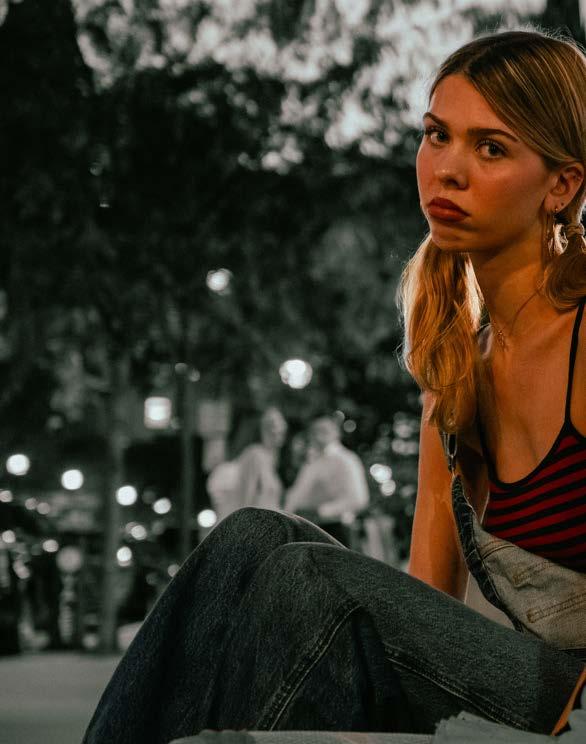
BY
DIRECTED BY EMMA BOWEN
PHOTOGRAPHED BY EMMA BOWEN
MODELED
AUDREY COLLINS AND KAIA RUBIN

“MAMA I’M A BIG GIRL NOW” EXPLORES THE ISOLATION OF GROWING UP AND REALIZING THAT WE’RE ALL GOING THROUGH THIS LIFE AT THE SAME TIME.
AS A VISUAL REPRESENTATION OF THE TRANSITION FROM ADOLESCENCE TO ADULTHOOD, WE ARE FORCED TO REALIZE THAT IT’S OKAY TO NOT KNOW EVERYTHING ABOUT THE WORLD — IT’S OKAY TO NOT KNOW EVERYTHING ABOUT YOURSELF, TOO. “MAMA I’M A BIG GIRL NOW” IS A REMINDER THAT WE ARE ALL IN THIS TOGETHER AS WE GO OFF INTO THE “REAL WORLD” AND TAKE ON “BIG GIRL” THINGS.
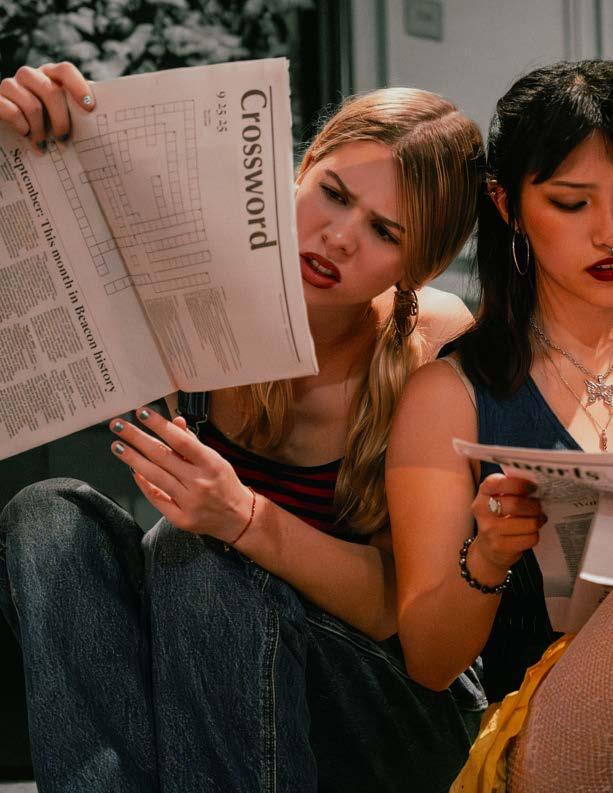


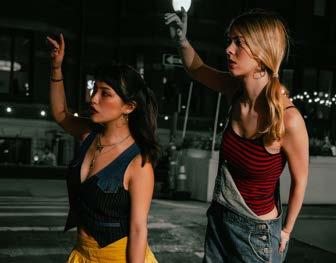








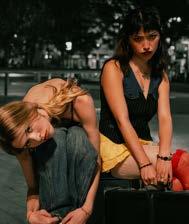











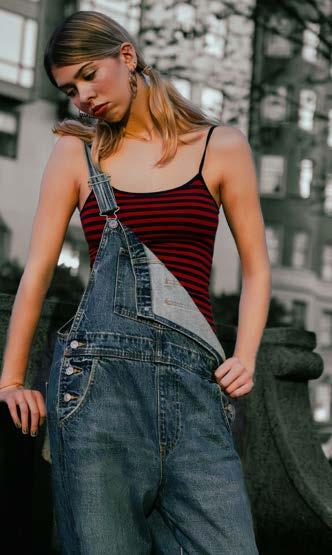







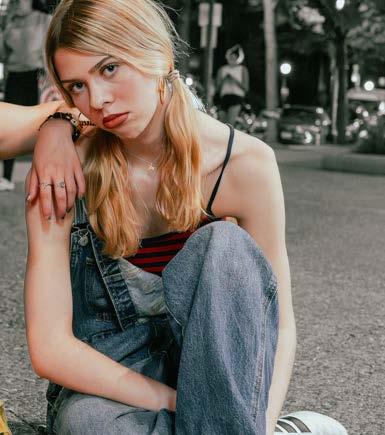







He Reads Didion, But…




Imet him first in Barcelona, in the dim light of a friend of a friend’s apartment. He wore a cropped graphic t-shirt and baggy jeans, his nails were painted black, and each knuckle displayed a different thrifted ring. We talked about reality television, as Love Island had just finished, but the conversation rapidly spiraled into a heated debate regarding the free use of filler injections. That’s when it dawned on me that I had encountered the star of the various contests across the country, from New York to Seattle: the performative man. Here was a man who, despite his blatant ignorance of various feminist ideologies, performed sophistication and sensitivity with immense conviction. And he somehow believed this performance was radical.
The joke of the performative man circulates widely: TikTok memes, “performative man” competitions, and think pieces in The Cut about soft boys and their thrifted cardigans. He has become a punchline, a cultural trope; and yet, the very performance that makes him charming online is the very same performance that is survival for a woman. As American gender studies philosopher Judith Butler puts it in their book Gender Trouble, “The effect of gender is produced through the stylization of the body and, hence, must be understood as the mundane way in which bodily gestures, movements, and styles of various kinds constitute the illusion of an abiding gendered self.” Gender is not naturally an inner truth we express but a socially constructed performance only sustained by constant “doing,” a performance women have had to uphold to dodge alienation and violence. Victorian women were taught music, embroidery, and language not for self-fulfillment but to increase marriage prospects; 19th and 20th century women writers wrote under aliases (George Elliot, Currer Bell) to gain publication and respectability; the Japanese Geisha was a master of arts, conversation, and subtle seduction performed not for pleasure but for livelihood within a strict social hierarchy. A performance exists even behind your “sexy” Joan of Arc Halloween costume, who dressed masculine for respectability and protection against sexual assault in her military ranks.
A woman who didn’t abide by gendered behavioral standards could be ostracized, raped, or branded a witch and burned at the stake, so we’ve become our own CCTV cameras, our own voyeurs. “You are a woman with a man inside, watching a woman,” Margaret Atwood writes in her novel The Robber Bride. We have trained ourselves to become the ‘Cool Girl,’ the one who’s easily digestible for the male palate. Gillian Flynn even wrote an entire monologue on this in Gone Girl: the girl who will guzzle shitty beer with you during Sunday night football, down hot dogs like it’s a competitive eating competition (but her waist is still the width of your pinky), and she always agrees enthusiastically to propositions of threesomes or anal sex. We must withhold anger at all costs and slap a cheesy smile on our face, but the performative man is taxing because he needs to carry the weight of The Bell Jar in his Trader Joe’s tote.
Or, more so, because his entire act is built on theft. Benson Boone croons ballads with mascara-stained lashes, Harry Styles struts in a Gucci dress on the cover of Vogue—and suddenly the cultural narrative applauds them as brave, edgy, visionary. But bell hooks already told us: the problem is not men experimenting with femininity, it’s that the credit and cultural capital always flow upstream to them. A woman wearing trousers in 1920 risked her livelihood; Harry Styles wears a tutu, and Twitter calls him “the future of masculinity.” I’d like to differ, but then again, the epitome of white masculinity is thievery, isn’t it?
This pattern is ancient. Even religion could not abide giving women ownership of creation: Genesis rewrites birth as man-made, a rib substituting for the uterus, the miracle of reproduction reframed so that men could claim authorship. It is our labor to remind them that they didn’t emerge from a single rib like some DIY Ikea project, that no deity drafted a blueprint with carpenter’s precision while we twiddled our thumbs. No, they came out of their mother’s womb after an agonizing eighteen-hour labor in stirrups she shouldn’t be in because King Louis XIV had a sadistic birthing kink.
And while these men supposedly read bell hooks and Simone de Beauvoir (even Adrienne Rich is too “underground” for their performance) their knowledge on feminist ideology is grossly lacking. I’ve encountered my fair share of performative men in the archaic times of my heterosexual dating, including the four horsemen of my own heterosexual apocalypse: the boy who carried tampons in his backpack, the boy who seduced by letting you lead in bachata, the boy who serenaded with cracking vocals on the guitar, and the especially notorious boy who showed me his Notes app poetry upon discovering I was a writer—poetry shockingly identical to Federico Garcia Lorca’s Gypsy Ballads. A sociopath, a slut-shamer, a pathological liar, and a narcissist, respectively (I had quite the taste, I know). But despite their performance of the sensitive, smart, feminist man, none of them could contribute to any discourse beyond abortion rights.
Men’s engagement with feminism often aligns with neoliberal ideals, presenting a version of feminism that is palatable and convenient until it challenges their own privileges. As sociologist Angela McRobbie observes in Notes On The Perfect, this form of feminism is “made compatible with an individualising project and is also made to fit with the idea of competition,” where the focus shifts to personal empowerment and choice, sidelining structural inequalities. The performative man I had the displeasure of meeting in Barcelona fought tooth and nail for “choice” feminism, yet drew a blank when I mentioned Marxism and intersectionality, terms so basic to any political discourse. This privileged ignorance reveals the limits of men’s commitment to feminism, supporting it only when it poses no real threat to their power nor the societal structures that provide them bountiful benefits. The performative man is a “feminist,” but when you mention large-scale systemic change, he shivers in his black leather Chelsea boots he thrifted in Berlin before you even knew who Phoebe Bridgers was. And that’s how I become this extreme feminazi because I condemn plastic surgery and the abuse of GLP-1 medication, words that provoke a selfproclaimed “choice” feminist man because it insinuates the dismantling of the very institutions which spoil them.
Fashion remains the performative man’s safe playground, where he can slip femininity on like a costume, preen for applause, then fold it neatly back into his closet before bedtime. He’ll curate antique rings and oversized cardigans like a museum exhibition, each look a carefully performed gesture signaling taste, sensitivity, and rebellion—but always one step away from risk. The performative man can play with femininity as an accessory and shortcut to cultural cachet, wearing eyeliner like courage without ever facing the cost women have paid for the same expression. He’ll read Didion and call it profound, but if Anaïs Nin ever crossed his desk, she’d be an abhorrent whore. Performance or not, he is still a man. YM

The Great Denim War
WRITTEN BY OLIVIA FLANZ
PHOTOGRAPHED BY OLIVIA FLANZ

The world is obsessing over denim…again! Some may say this is a trend, others say maybe we never left the denim craze. Jeans are a staple in our wardrobes, but it was a long road to get to the popularity of jeans today.
So let’s go back. The word itself stems from Genoa, Italy, where the textile “jean” or “Gênes,” the French word for Genoa, was produced throughout the 16th century. This fabric would eventually be dyed blue and popularized by dry goods merchant Levi Strauss and tailor Jacob Davis, forming Levi Strauss & Co., which we can still buy from today.
In 1871, the wife of a local laborer asked Jacob to make work pants that wouldn’t fall apart. He decided to put rivets— those small metal studs on the pocket areas of your jeans—on men’s work pants for the first time. Though rivets are now mostly decorative, they were initially Davis’ solution to a lack of stability in weaker areas of the pants, like the pocket region.
At the time, jeans were used solely for workwear, popular among farmers and miners during the California Gold Rush. So how did jeans go from workwear to the staple that is in everyone’s closet? A lot of it can be attributed to Hollywood, where Westerns glamorized rugged cowboy heroes—a legacy still echoed in today’s advertising. In the ‘50s and ‘60s, celebrities associated with style and rebellion also popularized the jeans. In River of No Return, Marilyn Monroe wore dark high-waisted jeans, a white cotton shirt, and a belt, and in Jailhouse Rock, Elvis Presley wore a Canadian tuxedo with a striped undershirt.
Trending again, denim-on-denim was born from a “rebellion.” In 1951, singer Bing Crosby was denied entry to a Vancouver hotel because he was wearing all denim. When the company Levi Strauss & Co. heard about the drama, they gifted him a full-on denim tuxedo, and hence, the “Canadian tuxedo” was created.
It’s not uncommon for jean marketing techniques to be born out of clapbacks: after American Eagle’s controversial Sydney Sweeney ad, Gap tapped Katseye, Levi’s brought in Beyoncé, Calvin Klein featured MINGYU, and Lucky Brand turned to Addison Rae. This whole summer and fall has just been a denim marketing war.
But denim has always thrived on reinvention. The reason jeans have always had a surge in popularity is because of their versatility, which is bound to attract brands and their fashion designers. The variations of jeans are endless. From the waist, to the wash, to the cut, there were so many ways to make jeans something new and exciting again. Which is why certain styles of jeans remind us of certain time periods. Bell-bottom jeans were popular in the ‘60s and had a resurgence in the ‘90s; lowwaisted jeans were first seen in the ‘60s and deemed as “hip-huggers,” mainstreaming in the ‘70s with the disco movement; high-waisted jeans jeans were common in the West, and had their first resurgence in the ‘90s under the title “mom jeans,” with another resurgence in the 2010s.
From that short timeline, it’s clear that, like any trend cycle, jean styles are constantly being revived and reimagined in mainstream fashion. A pair of jeans will never go out of style. Jeans continuously cement themselves as a timeless classic in our culture and our closets, and we know that there will always be a pair that everyone will want to wear. Denim never loses and will forever come out on top. YM

GETTING BACK TO GUCCI
WRITTEN BY JAGGER VAN VLIET
Anew, glamorous era at Gucci has begun and it feels… familiar.
Like an Italian starlet driving their Ferrari feels familiar. Like a big pair of sunglasses, and an even bigger fur coat, Gucci’s Spring/Summer 2026 (SS26) show was pure, unfiltered Italian chic. Under a new iconoclastic creative director, the renowned house of Gucci is tapping into a familiarity that is flexible, formative, and crucially, fashionable. It makes sense that after years of declining public interest, Gucci’s idea of revitalization is to go back to what makes Gucci…Gucci.
It’s no secret that Gucci has recently lost its way. Gone are the days when nascent SoundCloud artists would flaunt Gucci bags and double G monogrammed tracksuits. Those days went out the window when fashionable society began to question the logo-heavy designs that dominated an era of high-fashion streetwear. As labels like Bottega Veneta and Loewe embraced quiet luxury (to mass adulation), Gucci doubled down on styles that weren’t coveted anymore. Their previous creative director, Sabato De Sarno, made a valiant effort to shake things up, but the house has still been nosediving in profits for months, with last quarter’s sales dropping 25 percent year-over-year (Vogue Business).
Enter fashion’s resident disruptor: Demna Gvasalia. You love him. You hate him. You love to hate him. Readers may have done a double take; Demna at Gucci? Yes, that Demna. When the hiring was announced last March, the idea of the mononymic Georgian designer joining Gucci sent seismic shockwaves through the fashion industry at large. Plenty of names can be thrown into the ring when it comes to nonconformist fashion, but it doesn’t take an expert to know Demna frequently takes the cake. Whether at his own sardonic label Vetements, or during his stint as creative director of Balenciaga, Demna has never shied away from pushing boundaries. Think Kim Kardashian wearing a skintight dress made of caution tape. Think the cartoonishly oversized “Steroid” boots from Balenciaga’s SS23 collection. As the picture starts to form, it seems like Demna would be better suited for a directorship at KidSuper or maybe even Maison Margiela. But Gucci? Demna’s appointment as creative director of Italy’s most valuable heritage brand (Statista) marks a clear
turning point for Gucci: It’s time to make some serious changes. With the industry’s most chaotic designer at the helm, it came as a real shock when the debut was decidedly restrained.
This all begs one glaring question: why did Demna choose to play it so safe? Presented not on a runway but at a red-carpet short film premiere, Gucci’s SS26 collection was almost too reserved for a designer so famous for inviting mayhem. For the most part, the tailoring stayed self-contained to suits, furs, and leather products featuring the famous Gucci monogram. There was virtually none of the highly-anticipated absurdity that Demna tends to bring. Of course, there were some occasionally tasteful Demna-isms— mostly exaggerated shoulders and dramatic silhouettes. But in its entirety, the show was more by-the-books than not.
This might indicate that Demna is more interested in taking his time at Gucci. Instead of arriving with a spectacular firework show, perhaps Demna has decided that it’s better to get back to the basics. That’s certainly what this collection felt like: An homage to the simplest models of Italian style.
The collection bases itself around 37 core characters who loosely embody various archetypes of Italian culture. There’s Incazzata: the perpetually “pissed-off” fashionista. There’s Cocco di Mamma, or “mama’s boy.” There’s the Diva, Narcisista, and the dazzlingly pink Principessa. All these characters serve as a funhouse mirror which Demna uses to poke fun at Italian couture, the fashion world, and Gucci itself. The fits don’t need to be physically exaggerated when they already exude heavy don’ttalk-to-me energy.
Again, Demna returns to the basics as a means of guiding himself into his new role at Gucci. Where his predecessor, De Sarno, tried to capture the early days of Gucci, Demna has offered something close, but decidedly different. By delving into the literal identity of the brand, Demna is giving Gucci the respect it deserves—the respect that has drastically waned in recent years. He is reminding us just how stylish a gown and a good headscarf can really look. It’s not a direct copy of the past, but a careful taste of what is to come. A comically oversized blue coat, complete with matching blue fur collar, likely hints at Demna’s eventual plans, but for now, he seems content with offering the world a simple amuse-bouche—an ode to pure, classic Gucci. YM
ART BY IZZY MAHER


YOUR CLOSET

YOUR CLOSET ISAIAH
PHOTOGRAPHED BY EMILIE DUMAS INTERVIEWED
BY
KAT BOSKOVIC
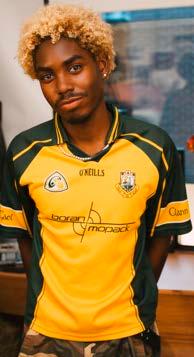


How would you describe your personal style in three words?
Queer business causal.
Where do you typically get outfit inspiration from?
Inspired by my favorite color or brand of the season!
What are three pieces in your wardrobe you can’t live without?
En route cross chain, XL full fur bag, and black leather jacket!
What song do you think best represents your style?
“Love You” by The Free Design. Who’s your celebrity style icon? Alton Mason!
If you could only shop at one place for the rest of your life, where would it be?

American Thrift—A thrift store in my hometown.




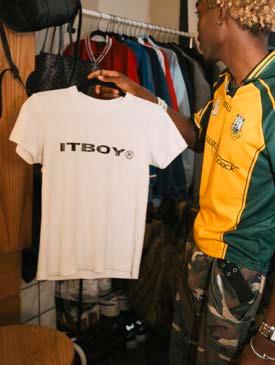




If you were a cartoon character, what would your outfit from your closet be?
FULL FUR FIT!
What’s your biggest fashion splurge? A Bottega Andiamo bag.
What’s one thing you would tell your younger self about fashion? He highkey knew more than I did.


TEHYA YOUR CLOSET YOUR CLOSET
PHOTOGRAPHED BY EMILIE DUMAS
INTERVIEWED BY KAT BOSKOVIC (she/her)
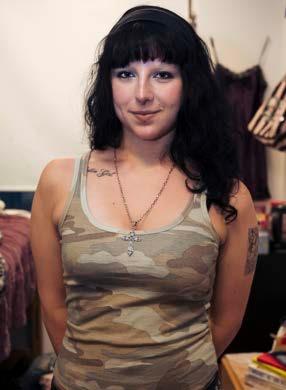










How would you describe your style in three words?
Romantic, grunge, McBling.
Where do you typically get outfit inspiration from? 2000s-2010s movies and Alexander McQueen shows. What song do you think best represents your style? “Ghost Highway” by Mazzy Star.
Three favorite accessories to add to an outfit?
My black “eye” purse, a scarf (a sheer scarf when it’s warm and a thick scarf when it’s cold), and my green emerald ring from my grandpa.
Who’s your celebrity style icon?
2000s Vanessa Hudgens.
If you could only shop at one place for the rest of your life, where would it be?
EBay (if that counts)
What are three pieces of your wardrobe you can’t live without?
My Lucky Brand jeans, my camo Realtree jacket, and my wedge sneakers.
If you were a cartoon character, what would your outfit from your closet be?
Striped hoodie, black lace tank top, gray Miss Me jeans, wedge sneakers, and a black sparkly headband. What’s your biggest fashion splurge?
Definitely my New Rocks.
What’s one thing you would tell your younger self about fashion?
Investing in good quality is worth it.

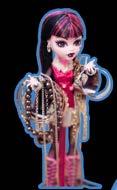



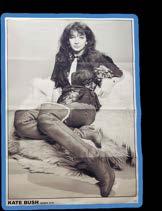

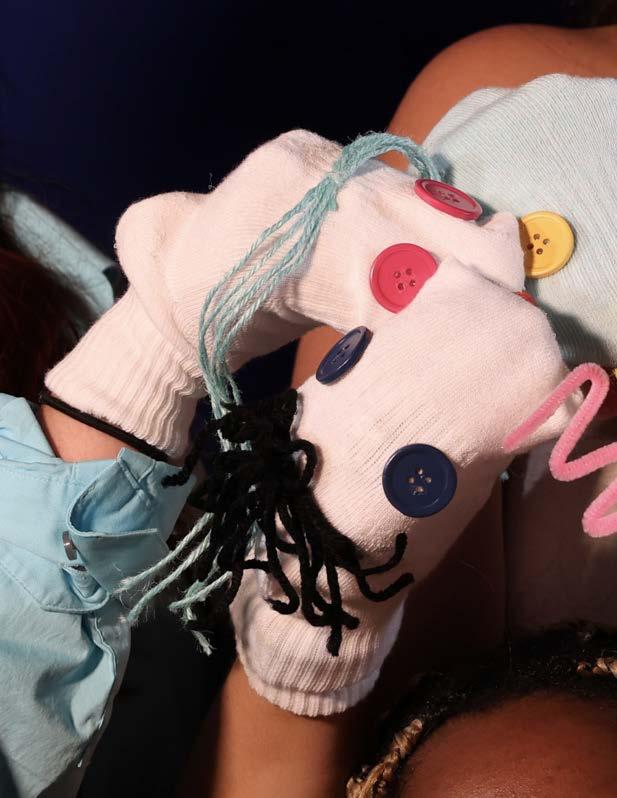
DIRECTED BY ROSIE
MCCONNELL
PHOTOGRAPHED BY JACOB GOLDBERG
STYLED BY EMILY HAMNETT
MODELED BY
LEXI KATZ, MAYA WACHLACZENKO, MCKENNA PARKER, ALEX POVENMIRE, FIONA CUNNINGHAM, DAIA JADE
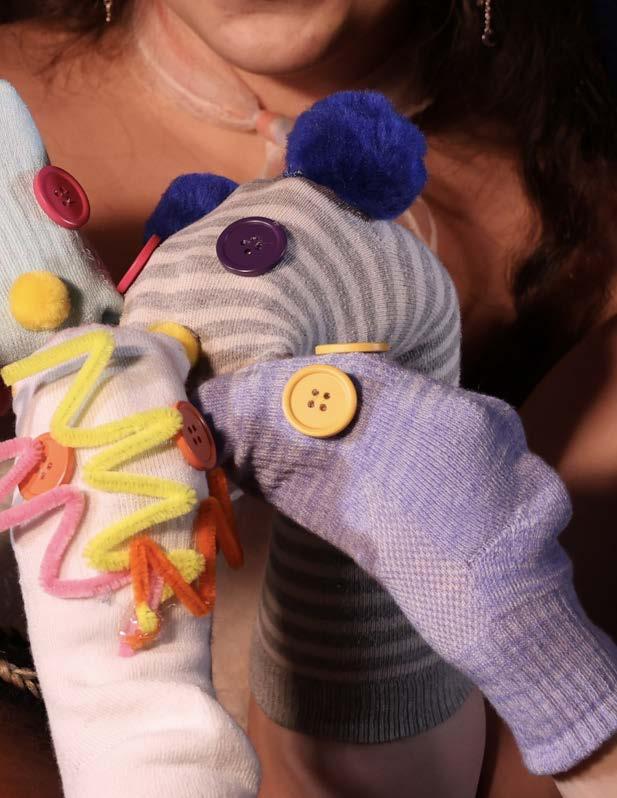
“THIS SOCKS!” IS A SHOOT DEDICATED TO MAKING ART JUST TO CREATE. IN A TIME WHEN EVERYTHING FEELS HEAVY, BEING ABLE TO CREATE ART JUST TO CREATE ART IS VALUABLE. WHILE CREATING SOMETHING WITH POWERFUL MEANING IS INCREDIBLY IMPORTANT, SOMETIMES YOU JUST NEED TO MAKE PUPPETS. AND THAT’S OKAY.












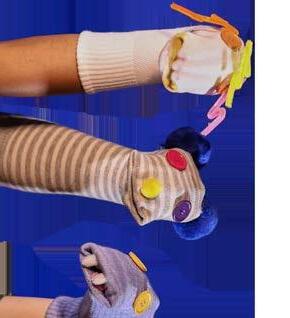


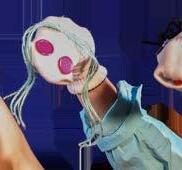
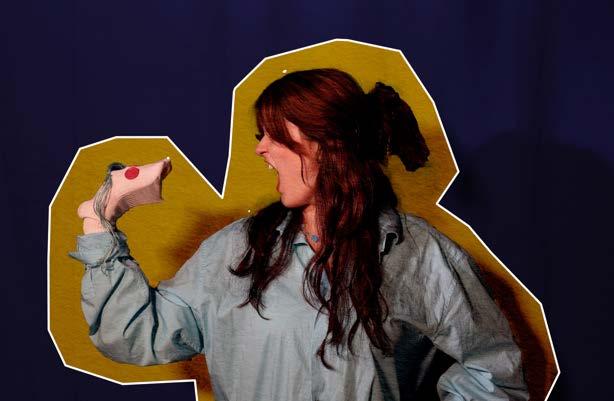








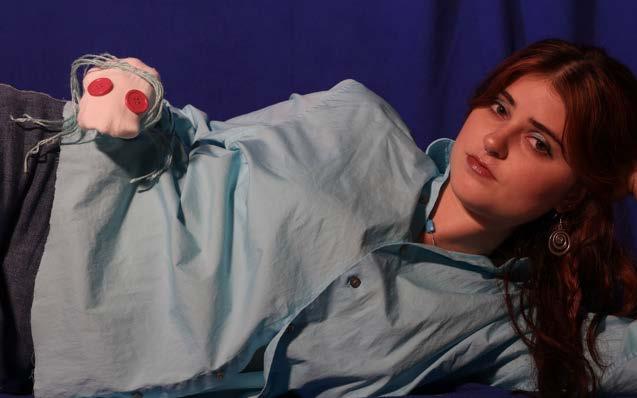










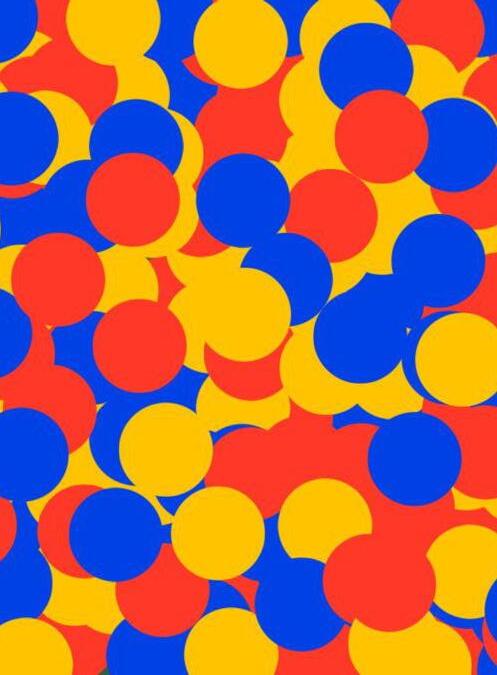
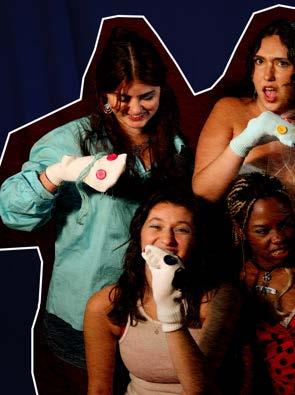









THE PROBLEM WITH SAYING “NO PROBLEM”
WRITTEN BY HEATHER THORN
Iwas 16 and fresh meat when I got my first job at a burger joint. As inexperienced as I was, I didn’t think twice when it came to ignoring my mom’s advice: Always say “You’re welcome” and never “No problem.” I was ever the angsty teenager and I fell into the throes of lunch and dinner rushes, piling drink orders, and managing a cash register—all with an eager smile on my face.
As a cashier and thus the face of a restaurant, it’s simple to become not a person but a machine. Human interactions are finetuned and automatic—the responses immediate, the smiles obligatory, and the small talk half-hearted. Customer service conversation boils down to a formula that sounds like this: Hi, how can I help you? Do you want fries with that? For here or to go? Cash or card? Quickly, I found myself ending each exchange by blurting out, “No problem.” Just like that, without realizing, those two words entered my vocabulary and stuck.
With experience comes thick skin calloused from the overly expectant customers who turn bold and vicious across the counter, an effect that’s multiplied when hunger enters the arena. I found myself shrinking my effort and labor in an attempt to please customers by assuring them it was “no problem” for me to serve them. I dismissed my work for others, thus minimizing the time and care I put into delivering excellent service.
My role as one of the many smiling, friendly faces at this burger restaurant was to provide prompt service, deliver food to tables, and do it enthusiastically. At the same time, my awkward refusal, even fear, to say “You’re welcome” to customers unintentionally made me a weaker worker not because I was doing less of a job, but because I was less certain of my worth as an employee. My urge to peopleplease and reassure customers that they weren’t an inconvenience to me made me think less of myself and in turn downplay the customer’s gratitude. In fact, “No problem” is an inherently negative phrase because it mentions a problem that’s not there, potentially implying that there was a problem or could’ve been.
Why was it so hard to say “You’re welcome”? At my first job I fell into the swing of things, blending milkshakes and refilling ketchup, and forgot about myself in the process. In the service industry, it’s easy—if not essential—to become invisible when you’re seen as a disposable worker by customers who just want their food and want
ART BY LAUREN MALLETT
it fast. In between specific orders—extra cheese, no onions, sauce on the side—the monotonous drone of working at a restaurant kicks in. In fact, it’s how I survive “clopens,” what restaurant veterans call a closing shift immediately followed by an opening shift.
I’ve been putting in elbow grease in the restaurant industry for the past four years and I now like to consider myself well-seasoned in food service. I work at a café in Beacon Hill where I caffeinate Bostonians part time. A few months ago, I caught myself blurting out “No problem” to a customer after delivering multiple plates to their table. From somewhere in the back of my brain among burger wrappers and cartons of fries, I recalled my mom’s advice.
The more I thought about it, the more I knew she was right, as mothers often are. I realized that saying “No problem” was inadvertently diminishing my work and lessening my self-worth. All of the breakfast, lunch, and dinner rushes I ever worked came flooding back. In all of my scrambling to steam milk for lattes, bring out orders, and fetch silverware and napkins, not once had I considered myself in the equation of customer service.
Along with the other robotics of customer service—all of the How can I help you?s and Would you like your receipts?—the phrase “No problem” sat on the tip of my tongue. It was an immediate response, but I felt less of myself every time I uttered the words.
“No problem” wasn’t immediately removed from my vocabulary. It was as stubborn as gum stuck to the underside of a table; it was lodged like cement in my vernacular. I started to consciously consider my response to customers when they thanked me. It took many tries, conversations, and oat milk cappuccinos, but eventually I started to accept customers’ gratitude and found myself feeling better at the end of every interaction. Now, the simple act of allowing myself to be thanked makes every shift a little sweeter.
This is a call to action no matter if you’re a well-oiled machine, lightly seasoned worker, or someone with no experience helping customers: Reassess how easily you might be dismissing yourself without realizing. You deserve recognition for your hard work, and that begins with you.
You’re welcome. YM






WRITTEN BY OLIVIA MAZZOLA
PHOTOGRAPHED
BY
ELIANA VEGA
For as long as I can remember, I lived with a soundtrack in my ears. My headphones were glued to my eardrums from the moment I woke up to the moment I went to sleep, blocking out unwanted thoughts and spiraling obsessions I wasn’t ready to face. At the heart of my need for constant noise lied a deep discomfort with the sound of silence. I was a music addict, of sorts, living in a melody driven bubble of bliss.
The bubble recently popped, however, when disaster struck and silence became unavoidable. At the beginning of my six-week study abroad excursion at Emerson’s Kasteel Well, my headphones broke, leaving me music-less and afraid. I panicked, unsure of how to survive the quiet. Sure, I would be in a major city the following week and could get a replacement pair then, but spending even a few days with nothing to fill the air sounded nightmarish. Just me and my thoughts. No playlist to drown them out.
The lack of constant noise was a shock to my system at first. Discomfort ran deep under my skin when insecurities got loud, and there was no longer an option to drown those thoughts out through pressing play. I itched for my beloved headphones and their ability to make my anxieties disappear.
But the initial unease and withdrawals soon wore off, giving life without headphones a chance to show me the beauty that lives in the quiet.
Instead of club music jolting me awake, my morning routines morphed into something slow and gentle. The silence turned them into a ritual for gathering thoughts and grounding myself. As I went about my day without a carefully curated playlist to hold my hand, I finally noticed how I was feeling, instead of how the music I chose to play made me feel. In the constant noise, I took on the emotions of whatever artist or chord progression played. In the silence, I heard my emotions in a new way. I listened to myself for the very first time.
By the time I got my hands on a replacement pair, I found myself letting the cheap, Dutch-branded wired earbuds collect dust on my desk. I still listened to music every day—I’m not a monster— just not all day.
Spending time in the hum of nothingness offered me time to slow down. It pushed me out of my comfort zone by forcing me to deal with unwanted thoughts, instead of just drowning them out.
The noise was always a temporary solution. As soon as I hit pause, the unwanted thoughts—the anxieties, the obsessions, the spirals—would circle right back. Embracing silence offered those pesky thoughts a moment to tire themselves out, giving clarity a chance to come to the foreground.
Our lives are filled with far more stimuli than we can handle. We are constantly scrolling, watching, reading, thinking; there’s only so much our brains can take. I hadn’t realized how much my brain needed a break from all of this noise, until existing in the quiet gave me a way to experience the world without the expectation of anything other than just being.
I still love my music, but I no longer rely on it to drown out my thoughts. Silence is not empty, or scary—it is space to breathe, space to reflect, and space that I can’t believe I now look forward to. YM



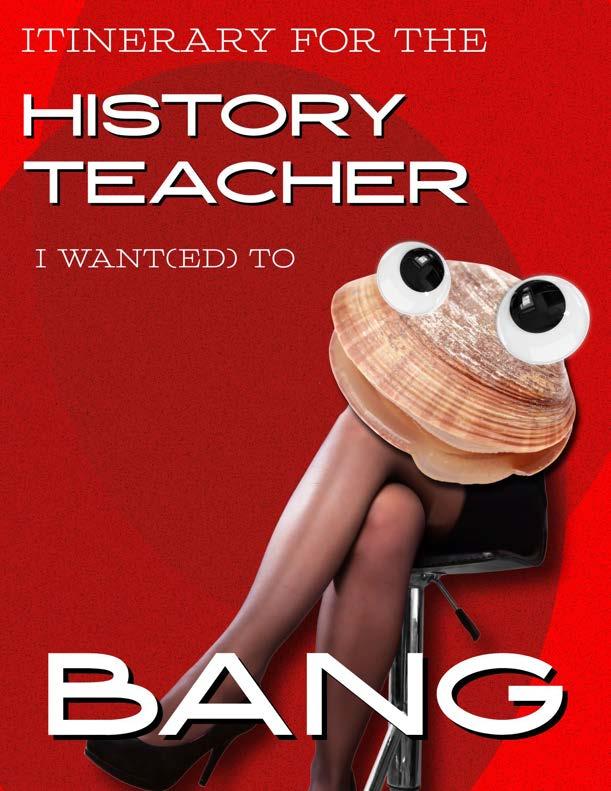
WRITTEN BY SAVIOR MUNEE
ART BY LUCY LATORRE
Icouldn’t find him after the scandal, since the woman he married went dark online, and he eventually left the high school. Nothing happened back then, but nothing could’ve. And, I might argue, all this time will have been well worth it. What we have is a single semester of subtext and years of yearning. I’m ready for him now—for us.
Our reunion will happen when I’m 23—when I’m comfortable enough to yell at my landlord and ask about “the optics” of a situation at work, but still rampantly fertile and bushy-tailed. I’ll email him—and by the grace of God, I will find his email—and we’ll meet at a bar attached to a hotel, and the next time either of us leave the building won’t be until the following morning. In my email, I’ll demand he doesn’t shave his face for a week and wears the tie I got him before winter break. The cheap polyester one with a Scandinavian flag.
I won’t be shocked when he walks in. He’ll still have that tight little bod from those years of biking, and greet me by my last name. I’ll call him by his first. He’ll order a pint of Guinness to start and ask why I’m laughing.
“Going to Europe in your twenties mentally stunted you,” I say. I remember the Kodak photos from Versailles, the way he lit up talking about the hostels and college buddies he lost touch with. Sexuality and pathology go hand and hand for me, and I hope he takes the opportunity with me, one he didn’t back then. Wine me, dine me, analyze me.
The same sentiment was true then. I was 16 and sexually disinterested in the guy I was seeing after he ignored me at a hockey game, because he got a boner from holding my hand, and he didn’t know the definitions to any of the words I was saying. Mr. B and I shared a similar desire to be in our twenties, and I looked down on him for it, sadomasochistically speaking. He wanted to go back. I only looked forward.
He’ll hold his glass in his right hand, and although he’d never admit it, he’ll intentionally keep his left hand hidden under the bartop.
“Your hair is so dark now,” he’ll remark, like he didn’t take me in from the get-go. I’ll instinctively touch my scalp to be certain it’s there, beaming like an elegant showpony. Or a bowl of buttered angel hair pasta.
I respond with the same face I used in class, a defiant look of wonderment, that told him I knew the answer, but was obeying his request.
“Give the other kids a chance,” he said then. Mr. B developed the habit of skipping the tedious grading process for some of my assignments, knowing it was a waste of time. Knowing I wouldn’t give him anything worse than perfect. It wasn’t difficult to push, to test what I could get away with. He only scolded me once, but promptly apologized after class.
“Sorry for being a dick,” he said. I affirmed.
He’ll order another beer, knowing the hair comment was a slip. Commenting on my appearance is acknowledging it exists at all, he couldn’t do that before. I’ll nurse my drink, a dark liquor, hoping it makes him nervous that I don’t need as much liquid courage as he might. I’ll omit that I arrived an hour before we agreed and downed two shots of the top shelf whiskey—the square bottle that my coworker Seb recommended. Seb says there’s a golf course in Michigan that lets you stay the night if you get drunk on this specific spirit. It goes down like maple syrup and makes me aloof about everything except old widows eating alone in Burger King. This is a detail I’ll take to my grave, unable to admit how contrived the night really is.
“I’m stepping out for a smoke.” He will guffaw at this revelation, and for the first time that evening will laugh with his entire face. I’m tempted to ask him to join. I won’t.
“You have fun with that,” he challenges. He doesn’t think I’ll do it. When I come back a few minutes later, I nudge my stool imperceptibly closer to him, enough for him to smell the layer of nicotine on my hands,
my neck, my mouth.
I’ll congratulate him on the son I’m almost certain he will have with his wife by the time we meet. Instead of thanking me, he will ask about school in the city. I’m reminded he’s approaching 40 because of the gray in his beard, the impact a few beers have on his cognition, and the persistent nature of his interest in the whims of young adulthood. And his disinterest in his own affairs.
He’ll be tipsy. I’ll be drunk. I bite.
“Why’d you leave?”
I remember from class his nervous habit of extending an opposite arm across his chest to scratch his half-beard. This night, his left hand will itch the right cheek, and I’ll make eye contact with a hardy wedding band.
He had four favorite students back then. We were relatively close to him in age, but closer in mentality. Tate had abusive parents. Manny dated dirtbags. Aaron was closeted. I was white trash. “You were the only one looking out for us,” I’ll argue. At its worst, it was a gray area. At its best, we were protected.
He’ll say there was nothing left for him at that school after our cohort graduated. Upperclassman whispered rumors sourced from a disgruntled student to first-years, and he was given the option to leave with his head high or fight it. He fought it at first, he says, but got older, tired.
I’ll hope he takes my silence as understanding, because my cheeks will be alight, and I’ll buzz thinking about how many rooms are still available the longer we play this game.
“I can’t believe you went through with it—the wedding,” I say. The first time he showed me a picture of the girlfriend-turned-fiance-turnedwife-turned-baby-mama, I took it as a joke. Her hair was light and frizzy and she looked intellectually unstimulating. He spoke about her with nothing but admiration, and I briefly weighed the merits of going to dinner at his house with Aaron for the sole purpose of getting a lock of her frizzy sink-water-shade hair to use for voodoo.
“You all turned out better than I could’ve imagined,” he’ll respond. “I’m really proud of you.” He’ll place a gentle hand on my shoulder, and remove it without looking particularly disturbed. We won’t break eye contact. I’ll crudely reach beyond my own bar real estate into his, taking his fourth or fifth pint in hand and finishing it in three slow, loud gulps.
We won’t break eye contact.
In the morning, we’ll silently dress and eat the free continental breakfast the hotel offers. His wife will call and he will spend eight minutes talking about the made up conference he went to and spend an additional three minutes talking to his kid. I won’t be able to recall how his wedding band ended up on my finger, but I’ll wordlessly unsheath it and put it on a napkin. I won’t intend for the gesture to trip him up, but it will nonetheless. My scrambled eggs are slick with sweat.
He’ll talk to his wife and son with food in his mouth, and I won’t be afraid to show repulsion on my face. It’s a deeply anti-erotic continental breakfast, enough to make me certain I had sex with someone else the night prior. He won’t apologize after he hangs up the phone, and I wouldn’t have wanted him to, anyway.
“October good for you?” he’ll ask as he clears the table.
“October works.” Blasé.
“I’ll email you.”
But that’s all contingent upon if he’s receptive to the email. And if he needs a refresher on who I am via yearbook photo. As long as his wife doesn’t see it. YM
IN LIVING
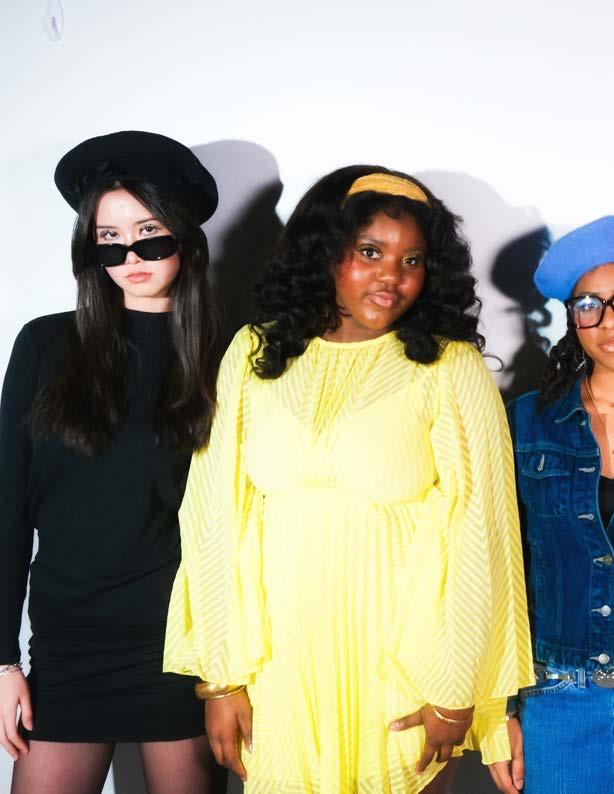
DIRECTED BY ELIJAH ST. KING
PHOTOGRAPHED BY ELIJAH ST. KING
MODELED BY SOPHIA TAYLOR, TRISTAN YOUNG, KELLY CHENG, VINCENT YAO KHOWONG, LAUREN WHITAKER
LIVING COLOR

WATCH AS EACH OF THE COLORS FEATURED IN PIET MONDRIAN’S WORK SPRING TO LIFE— INSPIRED BY THE COLORFUL AESTHETICS OF HIS WORK, THE THREE-STRIP PRIMARY DYE PROCESS OF TECHNICOLOR FILMS & THE COINCIDING VINTAGE FASHIONS FROM THE 50S-70S, OUR MODELS BRING COLOR TO THE WORLD OF HIS WORKS.
FROM OUR PORCELAIN SOCIALITE, OUR SCARLET ENTREPRENEUR, OUR BLUE BOOKWORM, OUR YELLOW WILD CHILD AND OUR ONYX ARTISTE— ENJOY THE WORLD OF PIET MONDRIAN. NOW “IN LIVING COLOR!”


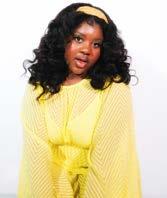

















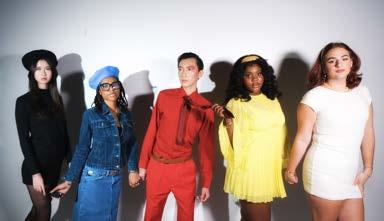




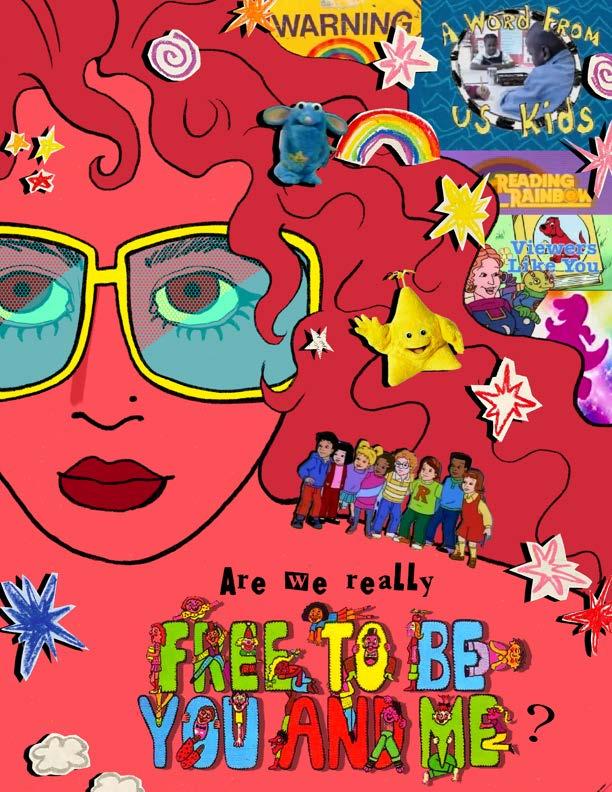
From 4th to 6th grade, I had the best teacher in the world: Ms. Carlson. She taught us about the corners of history that are too often left in the dust. From Howard Zinn’s A People’s History of the United States, we learned about Ida B. Wells and Cesar Chavez, diving deep into their lives and the movements they fought for. Ms. Carlson also showed us the children’s special Free to Be…You and Me, which introduced the class to a myriad of important discussions regarding gender roles, emotional regulation, individuality, and tolerance.
The special was aired in 1974 and was created by Marlo Thomas, in collaboration with Ms. Foundation for Women. Thomas was riding the wave of the ‘60s, which saw a slew of movements in the United States, including women’s rights and gay rights. Thomas was one of the founders of Ms. Foundation for Women, alongside other activists such as Gloria Steinem, and the foundation was rooted in diversity. Thomas collaborated with numerous actors and musicians to create a children’s special that upheld the values of diversity, inclusion, and tolerance. Through songs, sketches, and stories, “Marlo Thomas and Friends” introduced children to discussions of gender roles and stereotypes, encouraging them to lead with love, kindness, and understanding.
Little 4th grade me sat there, wide-eyed, and instantly fell in love with Free to Be…You and Me. From that day on, I established the belief that every child should watch this special.
The special begins with a title song:
“There’s a land that I see where the children are free / And I say it ain’t far to this land from where we are. / Take my hand, come with me where the children are free / Come with me, take my hand, and we’ll live. / In a land where the river runs free / In a land through the green country / In a land to a shining sea / And you and me are free to be you and me.”
The special leads with hope, which is fitting for the decade in which it was released. A time of turmoil and social unrest sparks a fire that is stoked by hope, action, and community. Sound familiar?
Media in general is becoming increasingly censored, and I worry for the ways it has and could continue to impact children’s media. When lessons aren’t taught in the home or the classroom, media can often mend that disconnect. Whether it’s songs, television shows, or films, children pay attention to what they are consuming, and it has the power to craft their outlook on life.
On the anniversary of 9/11 this year, I stumbled across an episode of Sesame Street that had aired just months after the attacks on



the World Trade Center. The episode followed Elmo after he experienced a small fire in the shop of one of his adult friends, Mr. Hooper. Clinging onto another adult friend, Maria, Elmo experiences fear and shock. He just experienced a traumatic event!
We observe as Maria reassures Elmo and a firefighter explains to him the importance of the work they do.

Elmo gets to visit the fire station, learns about fire safety, and works through his fear of going back to Mr. Hooper’s store again.
In a short episode, Sesame Street teaches a plethora of important lessons ranging from emotional awareness and regulation to basic fire safety. Children walk away learning what to do if they see a fire or smell smoke, and they recognize the effects that a traumatic event may have on them. The key here is that Sesame Street teaches these lessons in a way that children will understand best. Memorable characters, like Elmo, help children connect the dots between situations and themselves. After seeing Elmo interact with the firefighters, children can recognize that firefighters are people they can trust. The visual, sensory-friendly storytelling gives them the space and time to learn important life lessons. Children can relate to Elmo, who is only threeyears-old, and can learn from real-world situations on their television screens.
Children’s media shouldn’t just serve as entertainment; it should be educational. Young brains are malleable, and it makes a big difference when children consume material that teaches them about the inner and outer workings of the world. It helps them build awareness about themselves and others. It helps them understand emotions and social situations. Most importantly, it helps them lead with kindness, generosity, and understanding.
The Free to Be…You and Me soundtrack is timeless, and the cast involved reflects the diverse world we live in. It is a gem of a special, and I am eternally grateful that Ms. Carlson took the time to show it to our class. Public Broadcasting Service (PBS) had to close its doors due to a detrimental cut in government funding. Sesame Street was left without a home for months until HBO Max gave it a new place to live. We need to protect the children’s media that highlights the very values that can save our country from the horrors of authoritarianism.

Children are the future, and we must teach them well. We need Sesame Street to remain accessible. We need more Free to Be…You and Me’s in today’s world. If we cut off and censor important discussions, how are we ever going to see a land where you and me are free to be you and me? YM



Can Smiling FriendS Stick The Landing?



WRITTEN BY LUCY LATORRE PHOTOGRAHED BY EMA SABAU
The world of Smiling Friends is completely unpredictable—a character in and of itself. It prides itself on its weirdness, especially in the recent episodes where the show has become more comfortable exploring different animation mediums and expanding character design options. Some characters are hand drawn, others are 3D, and some characters are fully motion-captured humans. This unpredictability is what keeps the show interesting, with small jokes throughout every scene and in every minor character.
It would be so easy for the writers to put the emphasis of the show on how strange the world is, completely leaning into the unpredictability until it becomes predictable for the sake of it. Smiling Friends leans into the humor of the mundane. Smiling Friends doesn’t rely entirely on the world. Sure, it’s fun to get lost in the quirk, but it becomes so normal that the unpredictability is predictable.
In a show with such bright visuals, kooky characters, and unimaginable settings, absurdity is the norm. Sure, these absurd moments are funny, but they are funny in a way that fits the world rather than sticking out. The characters know where they are and interact with their world as we would with ours: with honesty, heart, and grounded, genuine reactions. But these aren’t reactions that say “Isn’t our world strange?”, alienating the audience and taking them out of the show. Smiling Friends is able to spark humor in an average conversation. Oftentimes, in the middle of an episode featuring strange creatures and epic journeys, characters will start having completely plain and believable conversations with each other. The characters react to the world around them in a completely realistic way, allowing the show to be bigger than just its world.
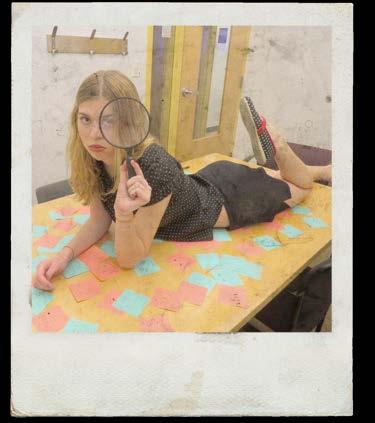

What really cemented this unique approach to an unpredictable world is the episode “The Smiling Friends Go To Brazil”, which aired shortly after the first season ended. From the title, fans were imagining a Smiling Friends version of Brazil, wondering what extreme moments were in store. Instead, the episode is 15 minutes of an incredibly realistic argument. The Smiling Friends don’t actually go to Brazil. Pim forgets to book the apartment, and they spend their time planning their next moves. The world stays the same–with the weird looking and strange shaped characters–but they are simply going about their business, taking a vacation. They just sort of exist. This sense of existence is what makes the concept of Smiling Friends as a business so touching. The problems of the characters in need of smiles stem from the world around them, sure, but their problems are relatively normal. Whether it is finding love, cleaning up their image, or just getting a better outlook on life, it isn’t the overwhelming world that causes problems, it just provides a backdrop with extra moments of comedy.
Smiling Friends has a chance to stick out among other adult cartoons. Typically, adult cartoons revel in the absurd. They use it for shock value and a dichotomy from the otherwise grounded, family centered content. The charm of Family Guy, South Park, The Simpsons, and even the occasional Bob’s Burgers episode is that these grounded settings are unique because of the absurd moments. Peter Griffin drives a tank around his quiet Delaware neighborhood. Cartman misses school because he has an alien tracking device up his ass. That’s not to say that these absurd moments are few and far between; they are expected after the long runs of the shows. For the show to have a successful run, this sense of normalcy in the extreme must continue to be balanced. The world cannot become too normal or else the show will lose what makes it so unique, but it also cannot lose its sense of groundedness and reality. The balance is what makes the show believable and likeable. It’s realism in an unrealistic world, allowing for a lot of heart in what could otherwise be a strange show, just for the sake of it.YM




Where’s My Conrad Fisher?
WRITTEN BY ELLA MORDARSKI
When I die I want my headstone to say I was Team Conrad. I need my future lineage to know I stood on the right side of history when it came to The Summer I Turned Pretty.
I first read the novels by Jenny Han when I was in middle school. They were everything a hopeless romantic could ever want, and gave me butterflies I can still feel a sense of today. The pages were filled with classic, romantic troupes, but still had the emotional complexity that comes with becoming a young woman. With every chapter I fell deeper in love with the characters Han had created. However, there was always one character that had my heart unlike the rest: Conrad Fisher.
Oh Connie baby! From the second you appeared on the page I kanew you would be one of my best parasocial relationships. Conrad was penned perfectly and his written presence was addictive like a shot of liquor. Brooding and introverted, Conrad was the definition of “you always want what you can’t have.” Every time you thought he couldn’t possibly get more attractive, he did, and executed it in such an irresistible way. As the novels progressed, Conrad just kept getting more and more alluring. He became emotionally vulnerable, made romantic gestures, and even wrote physical letters to the girl he had been pining for since childhood. All after his mother had died from cancer no less.
If The Summer I Turned Pretty books gave me unrealistic expectations for men, the adaptation ruined them for me permanently. The television version of Conrad goes to therapy
ART BY LAUREN MALLETT
regularly, dresses in some strapping coastal fits, can pull off a seamless U-turn, and knows his way around a fireplace. Pair all this with actor Chris Briney’s good looks, soundtracked by Taylor Swift songs, and you’ve got my version of kryptonite. I’m not the only one with a Conrad addiction, either. The internet is plagued with others who would also “risk it all” for the eldest Fisher boy.
So, why do we love Conrad so much? Unfortunately, I fear it’s because he is the most unrealistic fantasy of a straight man to ever exist. Conrad is the whole unobtainable package, wrapped in a handsome actor, gifted to us by a woman. He was specifically manufactured for Gen Z and Millennials, who have spent most of their lives surrounded by a dating landscape similar to a haunted house.
We are all somewhat envious and rageful of Belly. She got to skip all the shitty parts of dating like scrolling on the apps and meeting their parents. Instead Belly had a boy spend years yearning for her while he was becoming an oncologist, before confessing his feelings on a beach, and having a steamy sex marathon in Paris. Oh, and to really drive the knife in the jugular, Belly gets access to a multi-million dollar house in Cape Cod for the rest of her life.
Is it bad to indulge in the fantasy of Conrad Fisher? Absolutely not. I’ll be rewatching the show and patiently waiting for the movie like the addict I am. However, don’t go looking for your own Conrad Fisher because he doesn’t exist. If anything, date with the mindset to not find your Jeremiah Fisher. YM

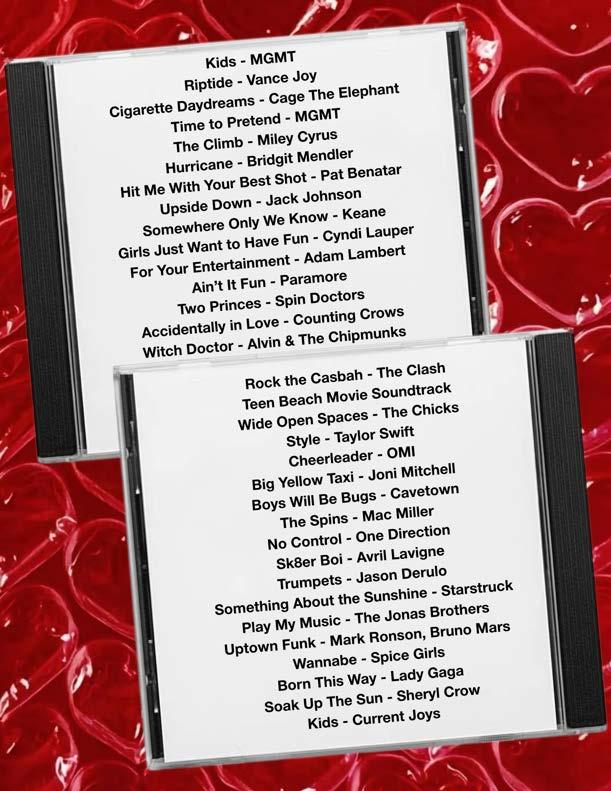

ARTIST STATEMENT IZZY CANTONE
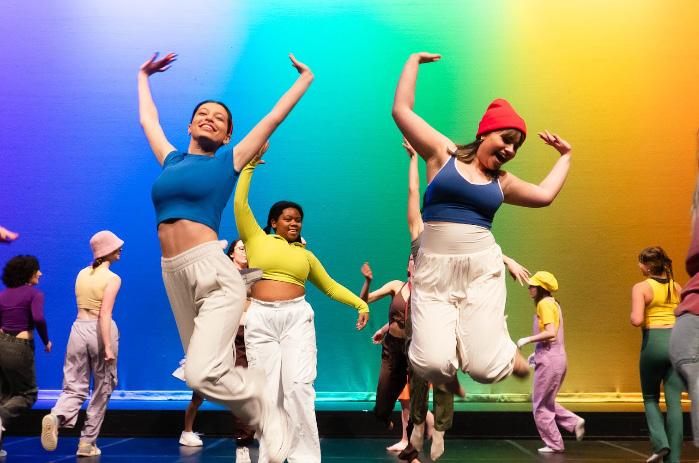
DESCRIBE YOUR WORK IN ONE SENTENCE. Telling a story and having tons of fun while doing it. WHAT INSPIRES YOU TO CHOREOGRAPH?
I’ve been dancing for so long I can’t hear any piece of music without imagining what kind of choreography I’d pair with it. If I’m listening to music and I look like I’m zoning out or talking to myself, chances are I’m choreographing new stuff in my head. WHAT IS YOUR HISTORY WITH CHOREOGRAPHY AND DANCING?
I started dancing at 6 years old, and since then never really stopped. I danced at a couple different studios, competed for a year, and then eventually started getting involved with musical theatre, where I got to dance even more. Through theatre I started getting interested in choreographing. In my senior year we did “Mamma Mia!”, and after telling me they wanted me to play Tanya, the director also asked if I wanted to choreograph Tanya’s number. After that experience I really fell in love with choreographing. Once I came to Emerson and got involved with Emerson Dance Company, I eventually gained the confidence to use my studio dance training to choreograph here! I have now choreographed 3 pieces for EDC, and have also choreographed for a couple student theatre productions as well.


WHO INSPIRES YOUR WORK?
I can’t say there’s a particular person that inspires my work, but I’ve lived through a lot of things in my life that taught me how lucky I am to have a body, a mind, and a place to dance and create art, because not everyone has that privilege. I hope I get to make art inspired by those who do not have the same voice or platform.
WHAT DOES CHOREOGRAPHING MEAN TO YOU?
It means I’m given the chance to tell a story completely through movement, without using any words. Sometimes I feel like when I’m able to express myself with my body like that it can be so much more powerful than just saying it.
CAN YOU DESCRIBE YOUR CHOREOGRAPHIC PROCESS?
Usually I’ll listen to a song over and over again and improv by myself to see what my body does!
WHAT IS YOUR FAVORITE PIECE YOU HAVE EVER CHOREOGRAPHED AND WHY?
In my sophomore year at Emerson, I choreographed for Mercutio Troupe’s “The Effect” by Lucy Prebble, directed by Taj Dharmadji. I created a movement piece to the song “coogie” by Dijon, in which the main two characters did a contemporary dance to represent finally giving in and falling for each other. I just remember seeing the final product and being so shocked yet proud of myself for creating something so vulnerable and so different for student theatre at Emerson.




WHAT ADVICE WOULD YOU GIVE TO ARTISTS INTERESTED IN CHOREOGRAPHING?
There is no 100 percent correct way to choreograph. You can literally do whatever your heart desires if it helps you tell a story. I still have to remind myself of it sometimes, but dance is such a universal language; it’s important to remember that whatever your creative vision is is worth seeing.
WHERE DO YOU SEE YOURSELF IN 10 YEARS?
My dream scenario would be to be here in Boston or back home in New York teaching theatre in a school! Plus, if I get really lucky, I’d love to continue dancing and teaching dance outside of a school setting.
WHERE CAN READERS FIND MORE OF YOUR WORK?
My instagram is @izcantone! I’ll also shout out my piece in EDC (@emersondanceco) “Goes Digital,” this fall! But besides my work, go support all of our dance orgs here at Emerson. EDC, EUDT, and EKStone are all stacked with incredible artists who ALWAYS give a fierce show!



